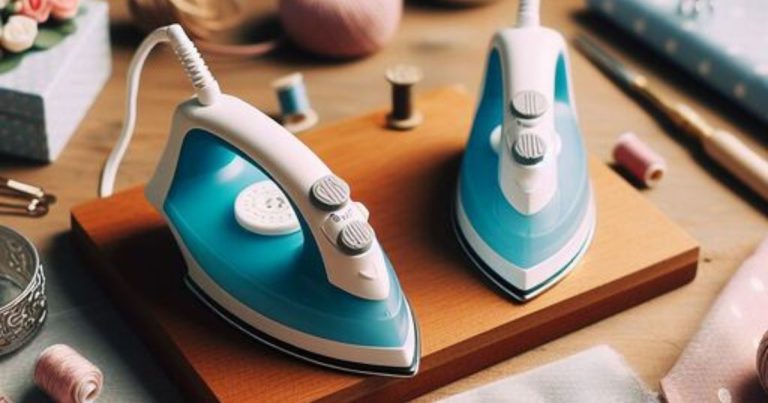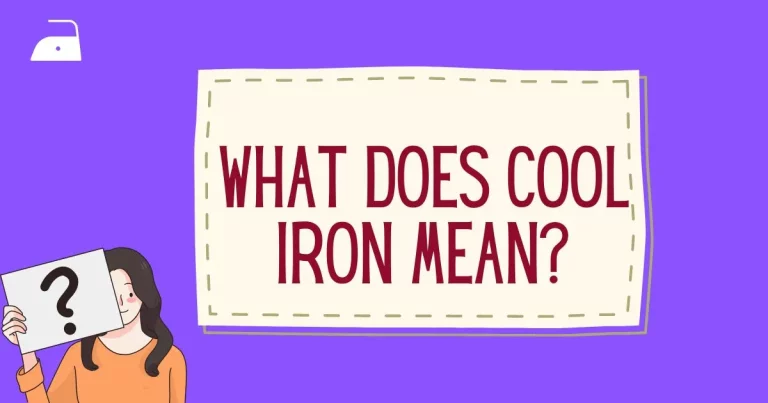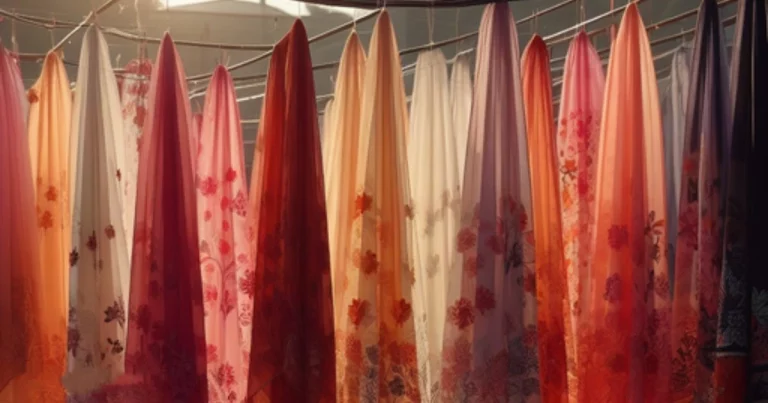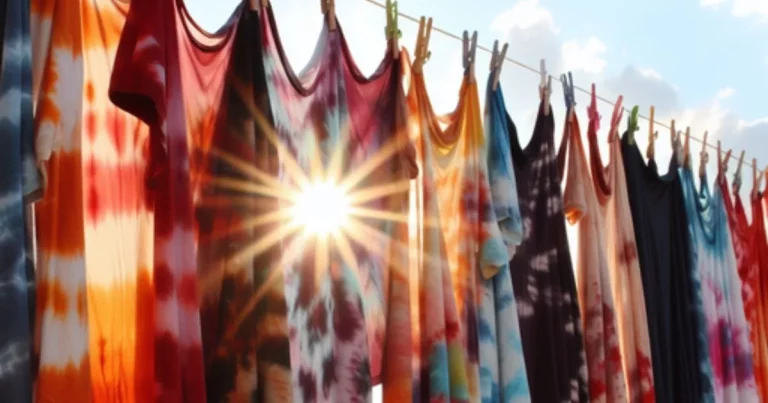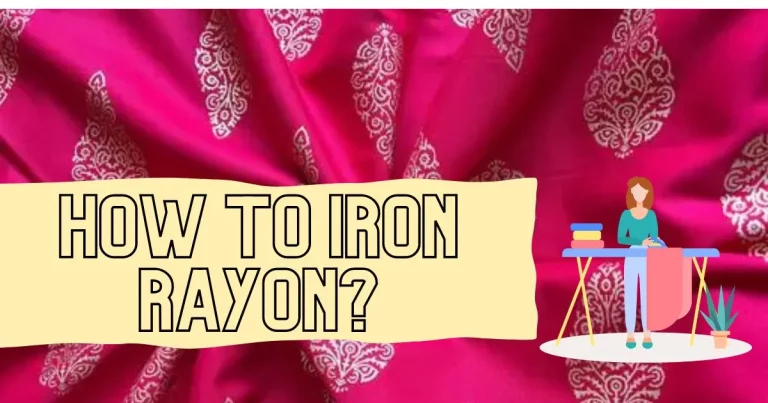IRON TEMPERATURE SETTINGS: THE COMPREHENSIVE GUIDE FOR IRONING ANY FABRIC
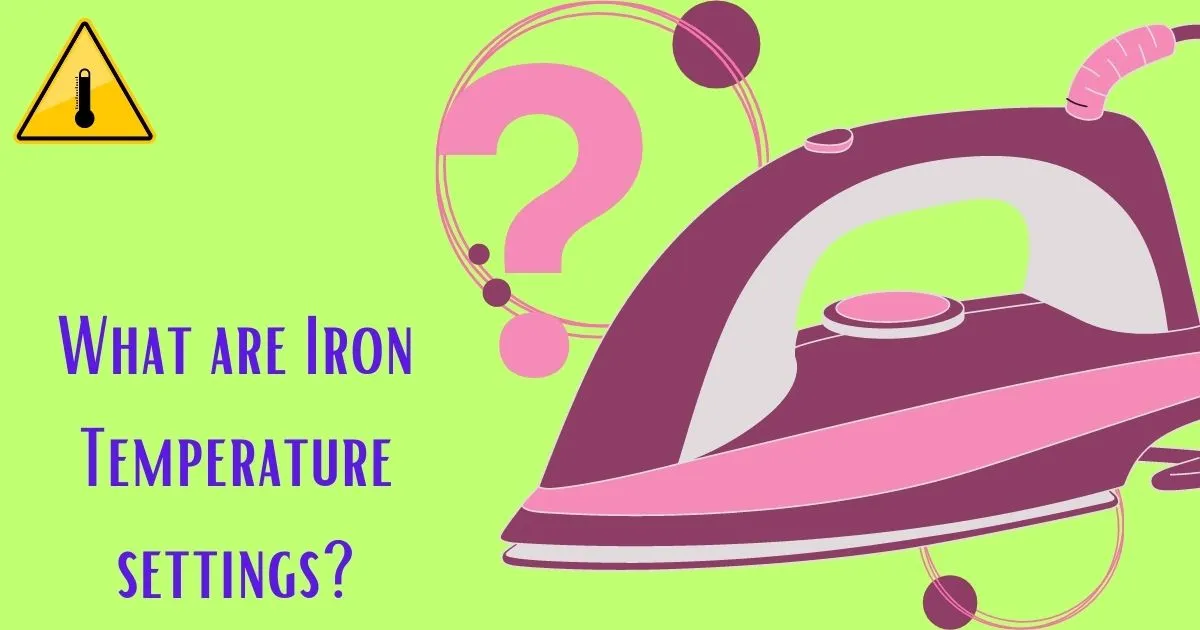
In the realm of garment care, mastering the nuances of iron temperature settings stands as an indispensable ally in ensuring our clothing appears crisp and impeccably polished.
Whether one is a seasoned professional or a novice in the art of fabric maintenance, this comprehensive guide is designed to provide invaluable insights into the intricacies of iron temperature settings. By delving into the science behind heat application, exploring the diverse fabric types, and elucidating the finest techniques for each material, this compendium endeavors to equip individuals with the knowledge needed to unlock the full potential of their irons and attain sartorial perfection with every press.
So let’s get started to get a deep knowledge for iron temperature settings.
Iron temperature Chart
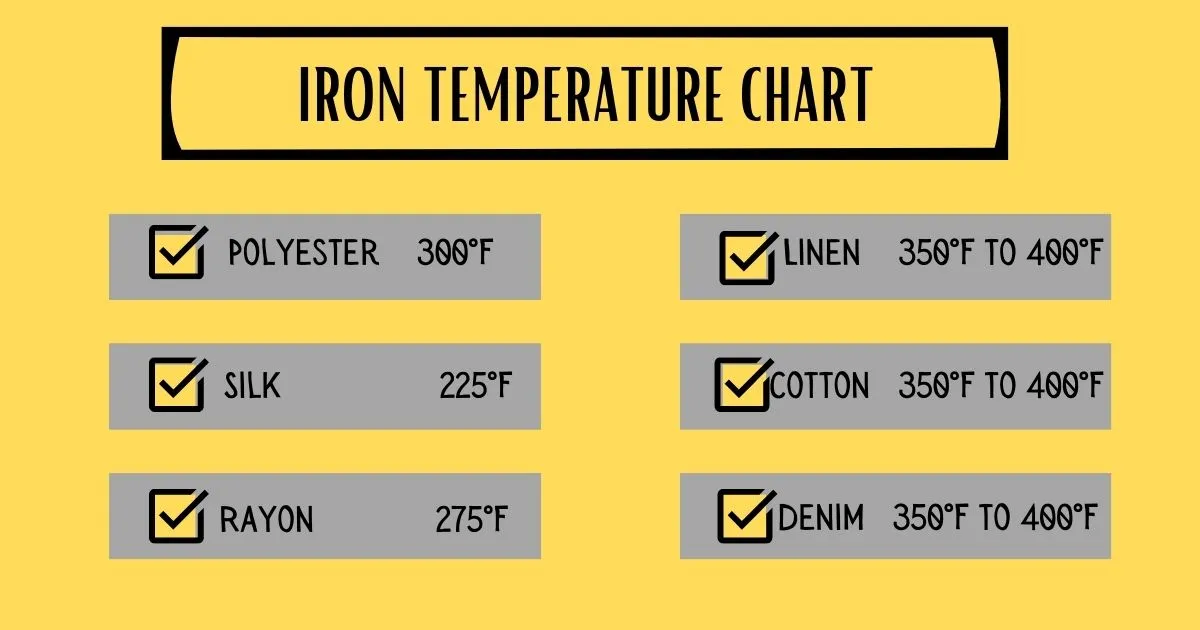
Ironing is an essential part of garment care that helps keep your clothes crisp, wrinkle-free, and presentable. However, achieving the perfect ironing results depends on using the right iron temperature settings for different fabrics. Selecting the appropriate iron temperature settings is crucial to prevent damage to your clothes and ensure effective wrinkle removal.
In this comprehensive table below, we will explore the best iron temperature settings for various fabrics, including polyester, cotton, rayon, wool, linen, and viscose (synthetic) materials.
| Garment Type | Iron Temperature (Celsius) | Iron Temperature (Fahrenheit) |
| Silk | 110°C | 225°F |
| Acetate | 110°C | 225°F |
| Cashmere | 110°C | 225°F |
| Velvet | 110°C | 225°F |
| Spandex | 135°C | 275°F |
| Viscose | 135°C | 275°F |
| Tencel | 135°C | 275°F |
| Nylon | 135°C | 275°F |
| Acrylic | 135°C | 275°F |
| Polyester | 150°C | 300°F |
| Rayon | 135°C | 275°F |
| Leather | No ironing | No ironing |
| Wool | 120°C to 150°C | 250°F to 300°F |
| Linen | 175°C to 205°C | 350°F to 400°F |
| Cotton | 175°C to 205°C | 350°F to 400°F |
| Corduroy | 175°C to 205°C | 350°F to 400°F |
| Denim | 175°C to 205°C | 350°F to 400°F |
As always, remember to refer to the care label of each garment for specific ironing instructions, and exercise caution when ironing delicate fabrics.
Low, Medium and High Temperature Settings for iron
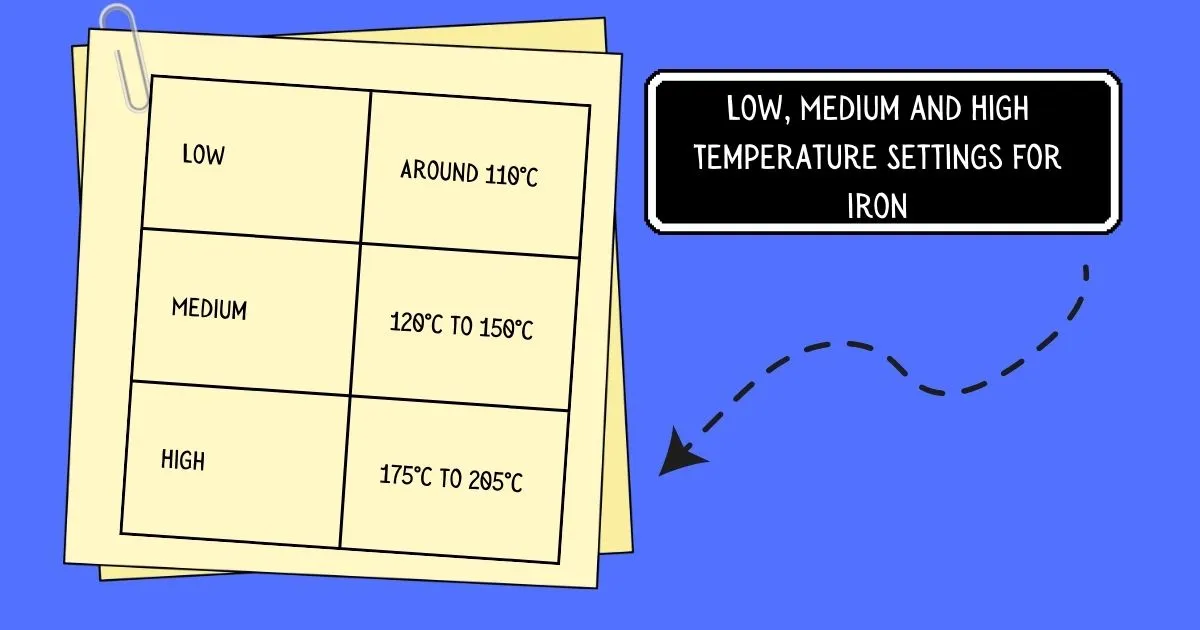
Proper iron temperature settings are vital for achieving professional ironing results and maintaining the longevity of your clothes. Always read the fabric care label and use the appropriate iron setting based on the fabric’s requirements.
| Ironing Temperature Category | Iron Temperature Settings (Celsius) | Iron Temperature Settings (Fahrenheit) |
| Low | Around 110°C | Around 225°F |
| Medium to Low | 120°C to 150°C | 250°F to 300°F |
| High | 175°C to 205°C | 350°F to 400°F |
| No ironing | Not Applicable | Not Applicable |
Understanding Ironing symbols for garment care

Ironing symbols are pictograms commonly found on clothing care labels and serve as a visual guide to help users understand the appropriate ironing instructions for a particular garment. These symbols convey vital information about the recommended ironing temperature, steam settings, and whether ironing should be avoided altogether. Understanding these symbols is essential to prevent damage to fabrics and ensure optimal garment care. Here are some common ironing symbols and their meanings:
Iron with Dots
This symbol features a single, two, or three dots inside the iron. The number of dots indicates the level of heat the garment can withstand.
Always adjust your iron’s temperature accordingly to match the number of dots on the label.
Iron with Lines
Similar to the iron with dots, the iron with lines represents different ironing temperatures. Instead of dots, you’ll find horizontal lines inside the iron. The number of lines indicates the temperature level—more lines mean higher heat.
Do Not Iron
This symbol is a simple crossed-out iron, indicating that ironing should be avoided for this garment. Some delicate fabrics or items with special finishes might carry this symbol to prevent damage.
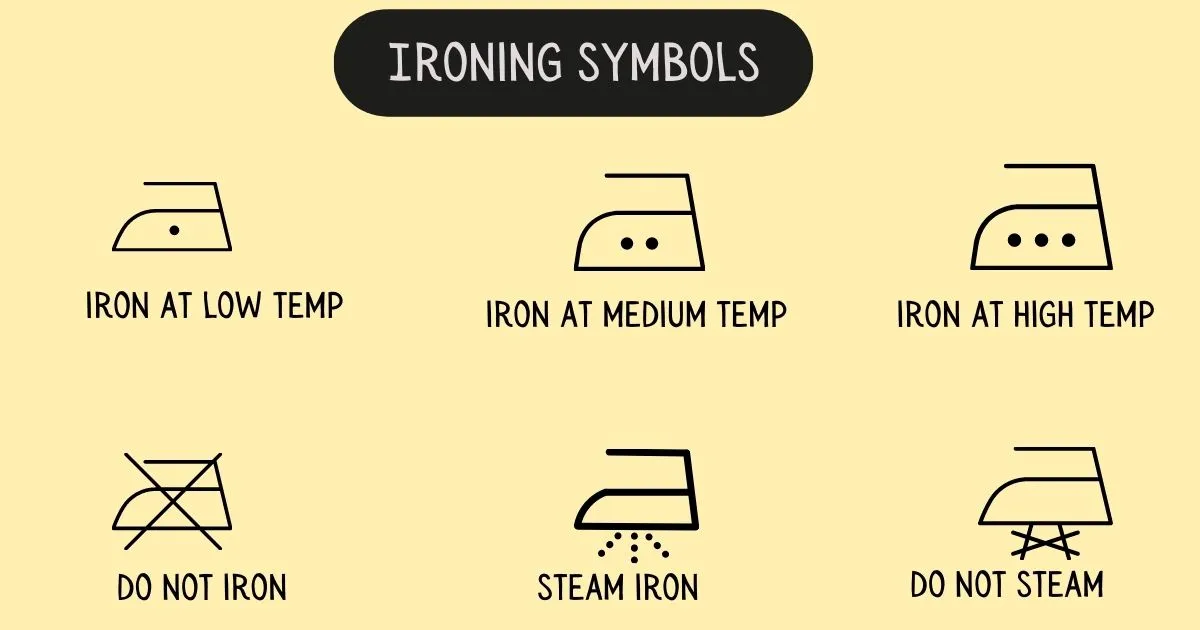
Steam Ironing Allowed
If you see this symbol, it means you can use the steam function on your iron when ironing the garment. Be sure to check the iron’s water tank to ensure there is enough water for steaming.
Steam Ironing Not Allowed
The crossed-out steam symbol indicates that you should not use the steam function while ironing this garment. Steam can harm some fabrics, so it’s essential to follow this instruction.
Dry Iron Only
This symbol shows an iron without steam, indicating that only a dry iron should be used. No water or steam should be applied to the garment.
Iron with a Cloth
When you see an iron symbol with an added cloth, it means you should place a thin cloth or press cloth (such as a cotton handkerchief or muslin) between the iron and the garment. This helps protect delicate fabrics from direct heat.
Iron Inside Out
This symbol, usually shown as an iron with an arrow around it, instructs you to iron the garment inside out. This practice is common for items with delicate prints or embellishments on the outside.
Iron with a Circle
The iron symbol inside a circle indicates that steam ironing is preferred but not mandatory. It is a recommendation, but you can still iron the garment without using steam if you prefer.
Ironing Temperature Settings for Fabrics – useful tips
Ironing temperature settings play a crucial role in maintaining the quality and appearance of your clothing. Here are some helpful tips to guide you in achieving optimal ironing results for various fabrics:
Read the Care Label
Always start by checking the care label on the garment. It provides essential information about the fabric composition and specific ironing instructions, including recommended temperatures and any precautions to be taken.
Sort Garments by Fabric Type
Sort your garments into different piles based on their fabric type. This will help you iron similar fabrics together, preventing accidental damage due to incorrect ironing temperatures.
Start with Low Heat
When in doubt about the appropriate iron temperature settings, start with a lower heat setting and gradually increase if needed. This cautious approach reduces the risk of scorching delicate fabrics.
Use a Press Cloth
For delicate fabrics or items with intricate detailing, place a thin press cloth or cotton handkerchief between the iron and the garment. This protective layer prevents direct heat contact and minimizes the chance of damage.
Test on an Inconspicuous Area
To get a better understanding of iron temperature settings, before ironing the entire garment, test the ironing temperature on an inconspicuous area, like the inside seam or hem. This allows you to ensure the fabric can withstand the heat without adverse effects.
Iron Delicate Fabrics Inside Out
When ironing delicate fabrics like silk or satin, turn the garment inside out. Ironing the fabric from the reverse side helps preserve its luster and prevents surface sheen.
Avoid Steam on Sensitive Fabrics
Some fabrics, such as wool or acetate, are sensitive to steam. Avoid using the steam function on your iron for these fabrics to prevent watermarks or distortion.
Use Vertical Steaming
For hanging garments or curtains, use the vertical steaming feature on your iron. This helps smooth out wrinkles without subjecting the fabric to the pressure of the iron’s soleplate.
Prevent Water Stains
When using a steam iron, ensure the water reservoir is clean and free from impurities. Avoid overfilling the tank to prevent water stains on fabrics.
Store the Iron Properly
After use, allow the iron to cool down completely before storing it. Always secure the cord neatly to prevent damage and store the iron in an upright position to avoid water leakage.
Regularly Clean the Iron
Clean the iron’s soleplate regularly to remove any residue or fabric build-up. Use a gentle cleaner or a mixture of vinegar and water to maintain the iron’s performance.
Use Ironing Accessories
Invest in a quality ironing board and cover. A padded cover provides a smooth surface and prevents imprints from the iron’s mesh.
By following these iron temperature settings tips and employing proper techniques, you can extend the life of your clothing and achieve wrinkle-free, professionally ironed results every time. Remember that each fabric has unique requirements, so attentiveness to the care label and a little practice will help you become an expert in ironing various types of fabrics effectively.
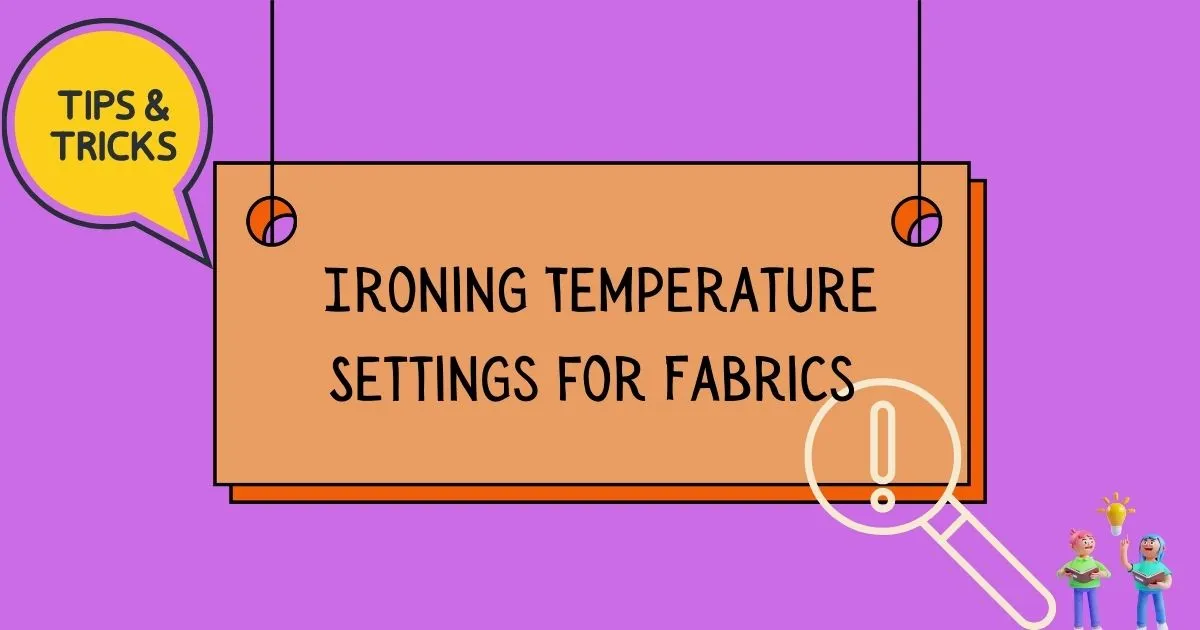
How to Manage the Temperature of Your Iron
Managing the temperature of your iron is essential to ensure effective and safe ironing for different fabrics. Controlling the iron’s temperature correctly can prevent damage to garments and help you achieve professional results.
Read the Instruction Manual
Familiarize yourself with your iron’s instruction manual to understand the different temperature settings and features it offers. Each iron model may have unique controls and options.
Check the Fabric Care Label
Always start by reading the care label on the garment you plan to iron. The label provides specific instructions on the suitable ironing temperature for that particular fabric.
Sort Garments by Fabric Type
Separate your garments into different piles based on their fabric type. Group similar fabrics together, as this will help you manage the iron’s temperature more efficiently.
Preheat the Iron
Before starting to iron, allow the iron to preheat to the desired temperature. Most modern irons have indicator lights or signals that let you know when the iron has reached the set temperature.
Select the Appropriate Iron Temperature Settings
Adjust the iron’s temperature setting based on the fabric you are ironing. For delicate fabrics like silk or synthetic materials, use a lower temperature. For sturdier fabrics like cotton or linen, opt for a higher temperature.
Use the “Low,” “Medium,” and “High” Settings
Some irons have simple settings like “Low,” “Medium,” and “High.” Match these settings with the ironing temperature recommendations provided by the fabric care label.
Pay Attention to Fabric Blends
For fabrics made of blends (e.g., cotton-polyester), use a lower temperature to avoid scorching the natural fibers while still smoothing out the synthetic fibers.
Test on an Inconspicuous Area
When dealing with a new fabric or a garment with an unknown ironing tolerance, perform a test on an inconspicuous area. This will help you determine the appropriate temperature without risking damage to the visible parts of the garment.
Use the Steam Function Wisely
If your iron has a steam function, use it appropriately. Steam can be beneficial for removing tough wrinkles, but avoid using it on sensitive fabrics that may not tolerate moisture well.
Iron Delicate Fabrics Inside Out
When dealing with delicate fabrics or garments with embellishments, turn them inside out and iron from the reverse side. This protects the fabric surface from the direct heat of the iron.
Adjust Temperature as Needed
Throughout the ironing process, adjust the temperature as required, depending on the fabric you are working on. Pay attention to how the fabric responds to heat and make adjustments accordingly.
Cool Down Before Storage
After ironing, allow the iron to cool down completely before storing it. This prevents accidents and prolongs the lifespan of the iron.
By following these tips and exercising caution when managing the temperature of your iron, you can confidently achieve wrinkle-free, well-pressed garments without compromising their quality or appearance. Remember to always refer to the fabric care label and, when in doubt, start with a lower temperature and work your way up to avoid damaging delicate fabrics.
Read more: Best Mini Irons
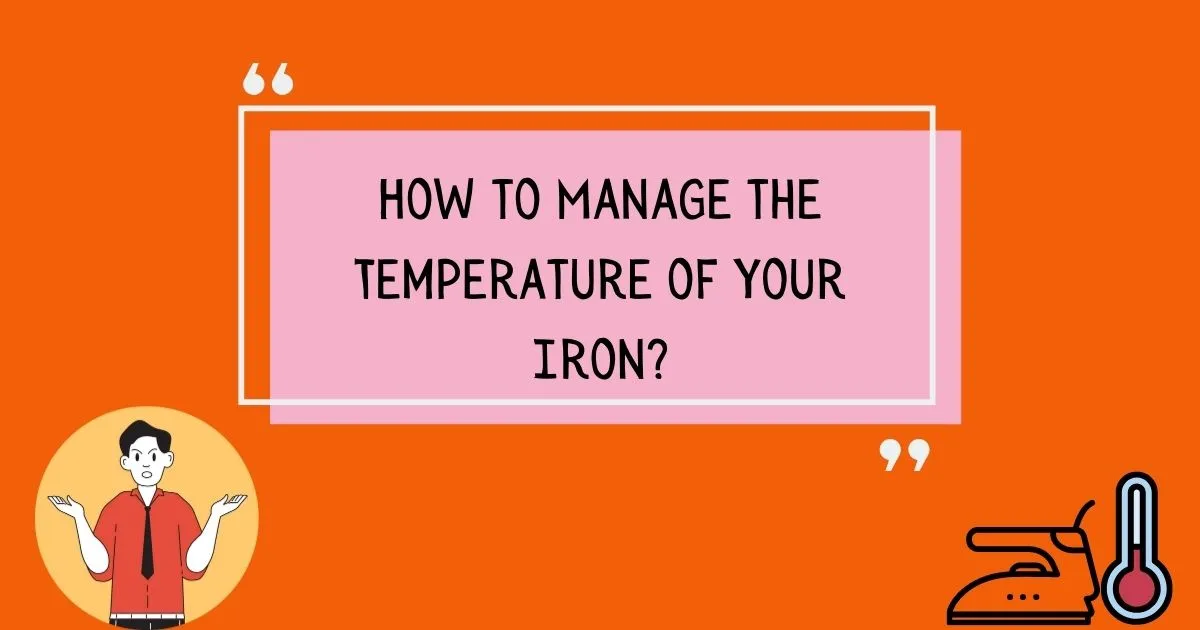
| Garment Type | Recommended Iron Temperature Settings | Best Tip for Ironing |
| Cotton | High (350°F to 400°F or 175°C to 205°C) | Use steam for stubborn wrinkles and press in a circular motion. |
| Linen | High (350°F to 400°F or 175°C to 205°C) | Iron while the fabric is slightly damp for easier wrinkle removal. |
| Wool | Medium to Low (250°F to 300°F or 120°C to 150°C) | Place a damp cloth over the garment and use low heat for gentle steaming. |
| Silk | Low (around 225°F or 110°C) | Iron on the reverse side or use a pressing cloth to avoid watermarks. |
| Polyester | Low (around 300°F or 150°C) | Set the iron to a lower temperature to prevent melting or damage. |
| Rayon | Low (around 275°F or 135°C) | Iron inside out and avoid heavy pressure to prevent shiny marks. |
| Nylon | Low (around 275°F or 135°C) | Use a low temperature setting to avoid melting the fabric. |
| Acrylic | Low (around 275°F or 135°C) | Gently steam the fabric to remove wrinkles without applying direct heat. |
| Cashmere | Low (around 225°F or 110°C) | Place a damp cloth between the iron and the garment for added protection. |
| Velvet | Low (around 225°F or 110°C) | Use a velvet brush or steamer to remove wrinkles without flattening the pile. |
| Denim | High (350°F to 400°F or 175°C to 205°C) | Iron the denim inside out for a smoother finish. |
| Corduroy | High (350°F to 400°F or 175°C to 205°C) | Use a steam iron to revive the corduroy’s texture. |
| Acetate | Low (around 225°F or 110°C) | Avoid using too much pressure to prevent shine or distortion. |
| Spandex / Lycra | Low (around 275°F or 135°C) | Iron gently to prevent damaging the stretchy fibers. |
| Viscose / Modal | Low (around 275°F or 135°C) | Iron inside out and use low heat to prevent sheen on the fabric. |
| Tencel / Lyocell | Low (around 275°F or 135°C) | Iron while slightly damp and avoid excessive pressure. |
| Leather | No ironing – Use other appropriate care methods | Use a leather conditioner to maintain its appearance. |
Recommended Ironing Temperature Settings
Remember to always refer to the care label on the garment for specific ironing instructions and exercise caution when ironing delicate or unfamiliar fabrics.
Iron setting for polyester
The iron temperature settings for polyester fabrics typically falls under the “Low” to “Medium” temperature range. Polyester is a synthetic fabric that is sensitive to high heat, and using a high-temperature setting can lead to irreversible damage, such as melting or scorching the fibers.
To ensure the best results when ironing polyester setting garments, it is recommended to set your iron to a lower temperature, around 300°F (150°C) or lower.
If in doubt, start with the lowest heat setting and gradually increase it until you achieve the desired results. Additionally, consider using a press cloth or ironing the garment inside out to further protect the polyester fabric from direct heat exposure. By being cautious with the iron temperature and employing proper techniques, you can maintain the shape and appearance of your polyester clothing without any undesirable effects.
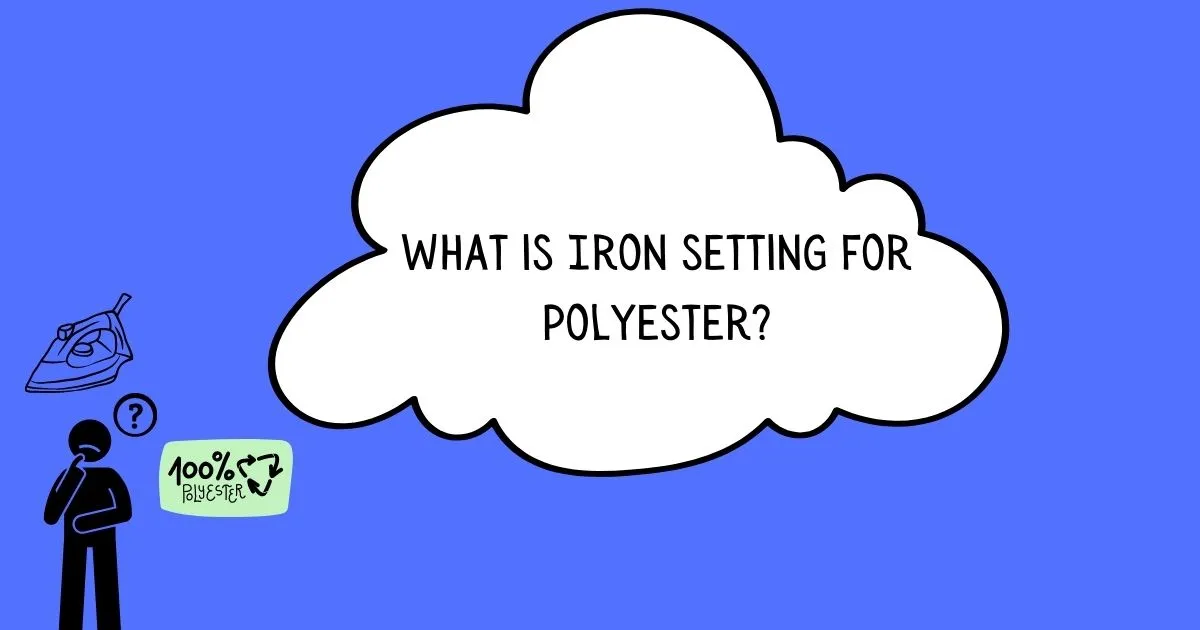
Read More: Best Irons For Quilting
How to remove shiny iron marks on polyester clothing?
To remove shiny iron marks on polyester clothing, follow these simple steps to restore the fabric’s smooth appearance:
By following these steps and being cautious with the iron’s temperature, you can effectively remove shiny iron marks from polyester clothing, restoring the fabric’s smooth and pristine appearance. Remember to always check the care label for specific ironing instructions and test on an inconspicuous area before treating the entire garment.
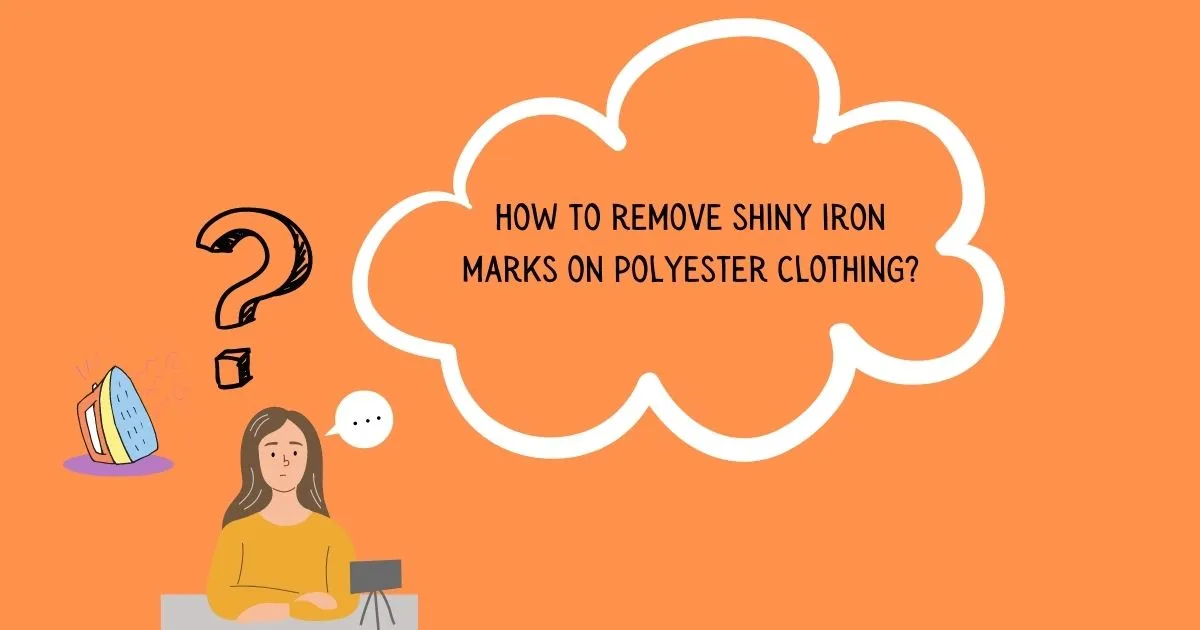
Conclusion – Iron temperature Settings
In conclusion, mastering the art of iron temperature settings is a key step towards achieving flawless garment care. With careful attention to fabric types and appropriate heat adjustments, one can effortlessly revitalize clothing while preserving their longevity and impeccable appearance. Armed with this knowledge, every ironing endeavor becomes a smooth and rewarding experience, leaving clothes impeccably pressed and ready to make a lasting impression.
Read more: How to iron a logo

